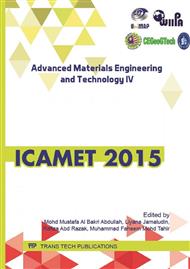[1]
Janotti, A. and Van de Walle, C. G: Reports on Progress in Physics, 72(12): 126501-126529. (2009).
Google Scholar
[2]
B.K. Sharma, N. Khare: J. Phys. D: Appl. Phys 43(2010) p.465402.
Google Scholar
[3]
H. Aourag, B. Khelifa, L. Hamerlaine, H. Belarbi, and A. Belaidi: Physics Letters A, 145(8-9): 455-460. (1990).
DOI: 10.1016/0375-9601(90)90314-e
Google Scholar
[4]
K.J. Chen, T.H. Fang, F.Y. Hung, L.W. Ji, S.J. Chang, S.J. Young, and Y.J. Hsiao: Applied Surface Science, 254(18): 5791-5795. (2008).
DOI: 10.1016/j.apsusc.2008.03.080
Google Scholar
[5]
D.C. Look : Materials Science and Engineering: B, 80(1-3): 383-387. (2001).
Google Scholar
[6]
J.W. Fergus: Journal of the European Ceramic Society, 32(3): 525-540. (2012).
Google Scholar
[7]
K.F. Cai, E. Muller, C. Drasar, and A. Mrotzek: Materials Science and Engineering: B, 104(1-2): 45-48. (2003).
Google Scholar
[8]
M. Chen, Z.L. Pei, C. Sun, L.S. Wen, and X. Wang: Journal of Crystal Growth, 220(3): 254-262. (2000).
Google Scholar
[9]
Y.Y. Chen, J.C. Hsu, P.W. Wang, Y.W. Pai, C.Y. Wu, and Y.H. Lin: Applied Surface Science, 257: 3446-3450. (2011).
Google Scholar
[10]
R.G. Parr and W. Yang: Density functional theory of atoms and molecules New York: Oxford University Press. ISBN 0-19-509276-7, (1989).
Google Scholar
[1]
R.M. Martin: Electronic structure: Basic theory and practical methods. Cambridge University Press ISBN 0-521-78285-6, (2006).
Google Scholar
[2]
J. Kohanoff: Electronic structure calculations for solids and molecules: theory and computational methods. Cambrigge University Press ISBN-10 0-521-81591-8, (2006).
Google Scholar
[3]
X. Gonze, B. Amadon, P.M. Anglade, J.M. Beuken, F. Bottin, P. Boulanger: Computer Physical Communication , 180: 2583-2615. (2009).
Google Scholar
[4]
M. Zhang, C. H. Zhang, J. Shen: Chin. PHys. B 20 (2011) 017101.
Google Scholar
[5]
P. Yang, Y. Zhao, H. Yang: Ceramics International 41 (2015) 2446-2452.
Google Scholar
[6]
J. Han, P.Q. Mantas and A.M.R. Senos: Journal of the European Ceramic Society, 21(10-11): 1883-1886. (2001).
Google Scholar
[7]
P. Li, S.H. Deng, Y.B. Li, J. Huang, G.H. Liu, L. Zhang: Physica B 406(2011)3125–3129.
Google Scholar
[18]
Z. Zhou, K. Kato, T. Komaki, M. Yoshino, H. Yukawa, M. Morinaga and K. Morita: Journal of the European Ceramic Society, 24(1): 139-146. (2004).
DOI: 10.1016/s0955-2219(03)00336-4
Google Scholar
[19]
X. Qu, W. Wang, S. Lv and D. Jia: Solid State Communications, 151(4): 332-336. (2011).
Google Scholar


